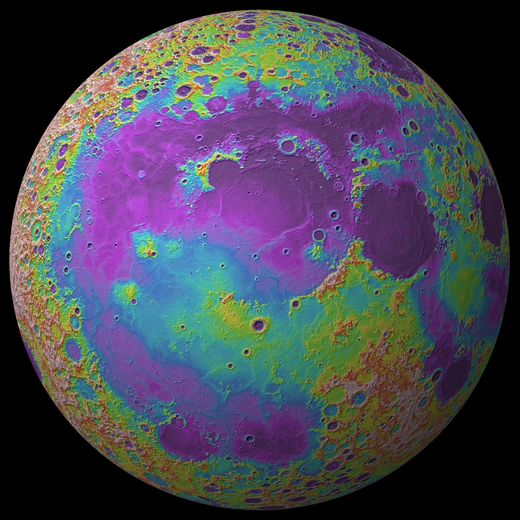
"Virtually everyone who has ever lived has looked up at the moon; and many of us have wondered, 'How did those dark areas get there?'" says Maria Zuber, geophysics professor and vice president of research at the Massachusetts Institute of Technology in Cambridge.
Now, planetary geophysicists say they have finally unlocked the secrets of a mysterious dark patch known as the Oceanus Procellarum, or Ocean of Storms.
Scientists have previously speculated that the vast lunar depression may have been caused by an impact with an asteroid or comet. But now a new analysis of gravitational data gathered by NASA's GRAIL mission suggests that the ridges around the depression are more likely remnants of an "ancient magma plumbing system."
Planetary scientists have known for years that some of the dark splotches on the moon seen from Earth were likely carved by lava. That lava had to have come from the interior of the moon, but there was no explanation for how it found its way to the surface, until now. The answer, it seems, has to do with the moon's gravitational field.
Everything that has mass exerts some degree of gravitational pull on the objects around it, explains study lead author Jeffrey Andrews-Hanna, who runs the Planetary Geophysics Lab at Colorado School of Mines in Golden, Colo. On an object as large as our moon, variations in density and topography can be detected by looking at variations in the gravitational field.
In 2011, NASA'S Gravity Recovery and Interior Laboratory mission sent two identical probes to study such fluctuations in the moon's gravitational field. As the twin GRAIL spacecrafts circled the moon, these fluctuations in gravity alternately caused the probes to pull ahead of each other as they passed over particularly dense lunar formations, explains Dr. Zuber, principal investigator on the GRAIL mission.
For a total of six months, these two crafts recorded the path of their dance around the moon, all the while transmitting their positions down to Earth, where researchers at MIT and the Jet Propulsion Laboratory in Pasedena, Calif. painstakingly calculated the subtly varying distances between the two.
"The beauty of this is it's an extremely simple measurement," Zuber says. "It's basically elementary school geometry but with the power of technology behind it."
The technology that Zuber refers to enabled the researchers to measure changes in velocity of the two spacecrafts to a couple of tenths of a micron per second.
"We are essentially measuring in a second distance changes that are a fraction of the size of a human red blood cell," Zuber says.
Using that data, Dr. Andrews-Hanna was able to construct a map of the moon's gravitational field with far superior precision than ever before.
"We've measured gravity at the moon before, but it's a little bit like the difference between an X-ray and an MRI machine," Zuber says.
Andrews-Hanna's map revealed previously unseen features of the Oceanus Procellarum.
"In the data we see these masses tracing out this giant polygonal data and we see almost a rectangle on the surface of the moon," Andrews-Hanna says.
Had the Oceanus Procellarum been caused by an impact, its outline would likely have been more round, Andrews-Hanna explains. His analysis suggests that these rifts are evidence of buried tectonic structures rather than the outer rim of a crater. He further posits that the formation of these rifts may have opened up pathways for magma to ooze to the moon's surface.
Andrews-Hanna is not exactly sure how those rifts might have formed, but he has an idea. Because, the moon does not have tectonic plates like the Earth, they must have been formed differently from the way our mountains evolved.

These radioactive elements produce a lot of heat and drive activity within planets and other celestial bodies. Over time, as the radioactive elements decay, they become cooler.
"This area would have started out hot and cooled with time; And as solids cool they contract," Andrews-Hanna says. "This region would have been cooling and contracting and would essentially pull away from its surroundings; And that would cause extension at its edges."
There aren't really any structures on Earth that compare in scale to this formation, Andrews-Hanna adds. But the same phenomenon occurs on a much smaller scale when mud puddles dry and crack.
The researchers published their findings in the October 2 issue of Nature.
Source: The Christian Science Monitor



Reader Comments
to our Newsletter